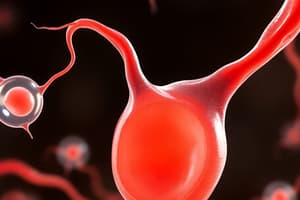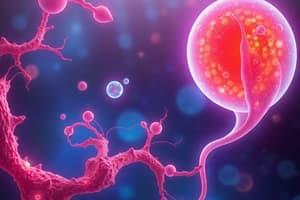Podcast
Questions and Answers
What is the haploid chromosome number in human gametes?
What is the haploid chromosome number in human gametes?
- 46
- 92
- 44
- 23 (correct)
Which of the following best describes the stages of oogenesis?
Which of the following best describes the stages of oogenesis?
- Follicular Phase, Ovulatory Phase, Luteal Phase
- Initiation, Maturation, Ovulation
- Prophase, Metaphase, Telophase
- Oogonia, Primary Oocyte, Secondary Oocyte (correct)
What is the first step in the spermatogenesis process?
What is the first step in the spermatogenesis process?
- Transformation of Spermatids into Spermatozoa
- Development of Primary Spermatocytes
- Maturation of Spermatozoa
- Formation of Spermatogonia (correct)
During which phase do spermatids undergo transformation into mature spermatozoa?
During which phase do spermatids undergo transformation into mature spermatozoa?
From which part of the embryo do primordial germ cells originate?
From which part of the embryo do primordial germ cells originate?
What major event occurs during Miosis I in spermatogenesis?
What major event occurs during Miosis I in spermatogenesis?
When do primordial germ cells differentiate into oogonia and spermatogonia?
When do primordial germ cells differentiate into oogonia and spermatogonia?
What does teratology study in embryology?
What does teratology study in embryology?
What is the haploid chromosome number of secondary spermatocytes?
What is the haploid chromosome number of secondary spermatocytes?
Which stage follows primary spermatocytes during spermatogenesis?
Which stage follows primary spermatocytes during spermatogenesis?
What is the role of Sertoli cells in gametogenesis?
What is the role of Sertoli cells in gametogenesis?
During which process do spermatids mature into sperms?
During which process do spermatids mature into sperms?
Which statement accurately describes the development of primordial germ cells (PGCs)?
Which statement accurately describes the development of primordial germ cells (PGCs)?
Which of the following best describes the initial division of type A spermatogonia in spermatogenesis?
Which of the following best describes the initial division of type A spermatogonia in spermatogenesis?
How many mature sperm are produced from one primary spermatocyte after all divisions?
How many mature sperm are produced from one primary spermatocyte after all divisions?
In the context of gametogenesis, what does oogenesis specifically refer to?
In the context of gametogenesis, what does oogenesis specifically refer to?
What is the main purpose of the acrosome during sperm development?
What is the main purpose of the acrosome during sperm development?
Which step in spermiogenesis involves the elimination of excess cytoplasm?
Which step in spermiogenesis involves the elimination of excess cytoplasm?
How long does it take for a spermatogonium to mature into a spermatozoon?
How long does it take for a spermatogonium to mature into a spermatozoon?
What percentage of sperm motility is deemed normal?
What percentage of sperm motility is deemed normal?
What key structure of the sperm tail aids in providing motility?
What key structure of the sperm tail aids in providing motility?
Which sperm disorder is characterized by an inadequate quantity of sperm?
Which sperm disorder is characterized by an inadequate quantity of sperm?
During which stage of spermatogenesis do spermatids develop into functional sperm?
During which stage of spermatogenesis do spermatids develop into functional sperm?
What components are found in the head of a mature sperm?
What components are found in the head of a mature sperm?
Flashcards are hidden until you start studying
Study Notes
Gametogenesis
- Defined as the conversion of germ cells into male and female gametes.
- Comprises two main processes: Oogenesis and Spermatogenesis.
Oogenesis
- The generation of female gametes (oocytes) from oogonia.
- Oogonia migrate and differentiate into primary oocytes during fetal development.
Spermatogenesis
- Sequence of events transforming spermatogonia into mature sperm, initiated at puberty.
- Begins with the recognition of germ cells in the sex cords of testes.
- Puberty triggers the development of seminiferous tubules which contain spermatogonia stem cells.
Spermatogonia
- Type A spermatogonia (44+X+Y) undergo mitosis to produce Type A and Type B spermatogonia.
- Type B spermatogonia develop into primary spermatocytes (44+X+Y).
Meiosis in Spermatogenesis
- Primary spermatocytes undergo the first meiotic division, resulting in secondary spermatocytes (22+X and 22+Y).
- Secondary spermatocytes undergo a second meiotic division to form haploid spermatids (23 single-structured chromosomes).
Spermiogenesis
- Process of transforming spermatids into mature sperm.
- Steps include:
- Formation of the acrosome to aid fertilization.
- Nucleus condensation.
- Development of neck, middle piece, and tail.
- Shedding excess cytoplasm, forming residual bodies phagocytized by Sertoli cells.
Duration of Spermatogenesis
- Approximately 74 days for a spermatogonium to mature into sperm.
- Mature sperm enter the seminiferous tubule lumen and migrate to the epididymis for storage and further maturation.
Structure of Sperm
- Average length: 60 microns.
- Components:
- Head: Contains nucleus and acrosome; essential for penetrating the ovum.
- Neck: Junction between head and tail.
- Tail: Three segments (middle piece, principal piece, and end piece) providing motility, with mitochondria in the middle piece supplying ATP.
Sperm Disorders
- Issues may include low sperm quantity (Oligozoospermia or Azoospermia) and quality defects.
- Diagnosis occurs through semen analysis and genetic testing.
- Key parameters:
- Normal sperm volume: 15-200 million/ml.
- Vitality: Expected at 54%, with critical levels below optimal.
- Motility and morphology are assessed for abnormalities (e.g., large/small head, crooked tails).
Embryology
- Study of developmental processes post-fertilization.
- Karl Ernst von Baer is recognized as the father of Embryology; key terms include:
- Embryogenesis: First 8 weeks of human development.
- Fetal period: From week 8 until birth.
- Teratology: Study of birth defects.
Mitosis vs. Meiosis
- Mitosis: Cell division producing two identical daughter cells.
- Meiosis: Two-stage division generating male and female gametes, resulting in haploid cells.
Summary of Gamete Development
- Primordial germ cells (PGCs) migrate to form oogonia and spermatogonia by the 5th week of development, marking the initial stage of gametogenesis.
Studying That Suits You
Use AI to generate personalized quizzes and flashcards to suit your learning preferences.




